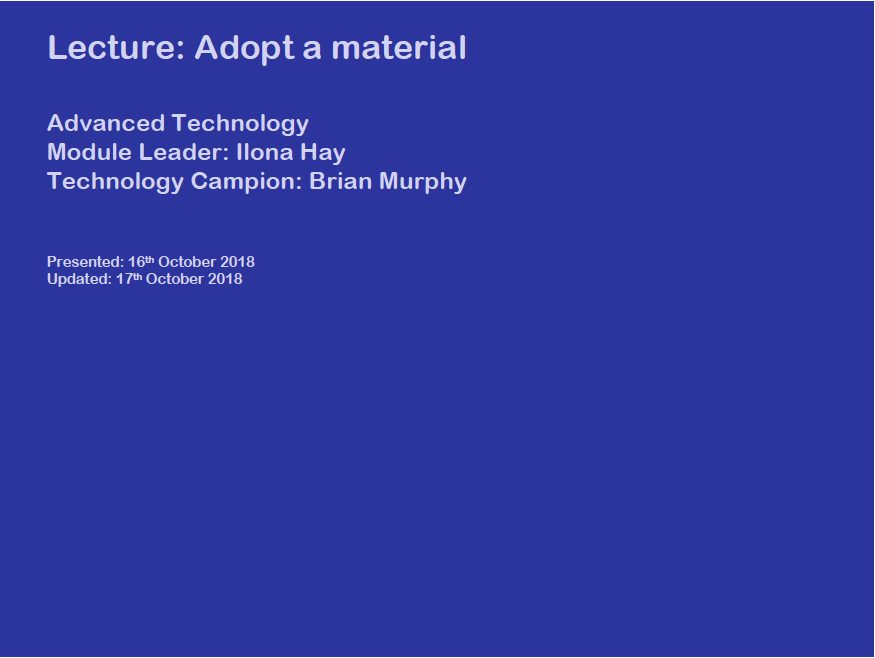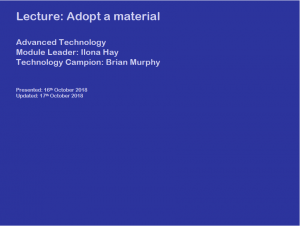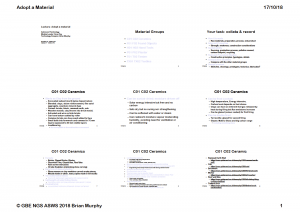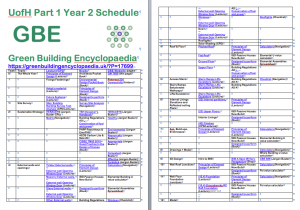
Adopt a Material Lecture
GBE > Encyclopaedia > Files > Lectures > Topical > Material > G#19183
Adopt a Material Lecture
About:
- File Name: GBE Lectures Adopt A Material
- File Type:
- PDF Handout
- PDF Show
- PPTX Show
- File Size:
- 68kb (9H5 PDF Handout)
- 95kb (S45 PDF Show)
- 132kb (PPTX)
- Number of Slides: 45
- Scope: Ceramic, Timber, Found Objects, Plaster, Textile, Hand tooled materials, Laser cut materials, How they are made, Properties, Sustainability, Applications
- Extract: See whole text below
- Content: See whole text below
- Created for: RIBA Part 1 Year 2 Architecture students
- Presented to: University of Hatfield
- Author: BrianSpecMan aka Brian Murphy BSc Dip Arch (Hons+Dist)
- © GBE NGS ASWS 2018
- Created: 16/10/2018
- Revision: 1
- Updated: 17/10/2018 (28/10/2018 in website content)
- Previously published on Scribd: not applicable
- Scribd reads: 0
- CI/SfB: g clay (dried fired), h metal, i wood, q lime cement binders, r clay gypsum,
- CAWS 1987: F10 Brick Block, H60-H67 Roof tiles, M40 Tiles, Z11 Metals, G20 Timber, Z10 Timber, K21 Timber floors, M20 Plaster, M52 wall linings, N10 Fabric
- CAWS 2012: NN:NN:NN
- Uniclass 1 1997: LNNNN
- Uniclass 2 2012:
- Uniclass 3 2015:
- Tags: Materials, Properties, Manufacture, Impacts, Applications, Sustainability, Environmental
- ProductSets: Materials, Applications, Methods of Construction, Building Elements,
- UserGroups: Students, Architects, Assistants, Technicians, Structural Engineers, Constructors
© GBE NGS ASWS Brian Murphy aka BrianSpecMan *
16th October 2018 – 22nd November 2018
Adopt a Material Lecture
Images:
University Logo


GBE Lecture Adopt a Material BRM171018 S1
Cover Slide

GBE Lecture Adopt a Material BRM181018 9H1
Handout Cover
Links Schedule

UofH Part 1 Year 2 Schedule A03 BRM 201018 PNG
GBE Lecture Adopt a Material BRM171018 9H5 handout PDF
Handout for printing (PDF)
GBE lecture Adopt a Material BRM171018 S45 Show for Viewing PDF
Show for viewing (PDF)
GBE Lecture Adopt a Material BRM171018 PPTX
Show for editing (PPTX)

UofH Part 1 Year 2 Course and Lecture Series Schedule A02BRM171018 PNG
Course and Lecture Series
© GBE NGS ASWS Brian Murphy aka BrianSpecMan *
16th October 2018 – 22nd November 2019
Adopt a Material Lecture
See Also:
GBE Links
- UH Part 1 Year 2 Task Schedule (Links) G#17699

UofH Part 1 Year 2 Schedule A03 BRM 201018 PNG
GBE Lectures
- Subjects
- GBE Lectures Subjects G#715 N#737
- GBE Lectures G#480 N#486
- GBE Lectures Satisfied Customers
RIBA Part 1 Undergraduate
RIBA Part 1 Year 2 Course
- UH Part 1 Year 2 Task Schedule (Course) G#17699
RIBA Part 1 Year 2 2018-2019-2020 (University of Hertfordshire)
- S1 Adopt A Material (Studio Lecture) G#19183 2018-2020 (this page)
- L1 GBE Building Envelope Principles (Lecture) G#31815 2019/20
- L2 GBE Introduction to Materials (Lecture) G#31821
- L4 External Walls, Openings Windows Doors (Lecture) G#19226 2018/19
- L5 Floors Ceilings Partitions (Lecture) G#31829 2019/2020
- L6 Future Systems: Services (Lecture) G#31831
- L9 Future Systems: Sustainability (Lecture) G#20396
- L14 (24) Stairs Ramps Balustrades Ladders (Lecture) G#19526
- L14 (66) Lifts Escalators (Lecture) G#19526
- L15 Design and Detailing to Perform (Lecture) G#20475
- L17 Future Systems: ITC Technology (Lecture) G#20897
RIBA Part 1 Year 1 Elements
- C11 Ground Investigation (Lectures) G#403
- (11) Site, Ground, Floor (Lectures) G#2111
- (13.1) Ground Floor (Lectures) G#2112
- (16.4) Foundations (Lectures) G#2113
- (16.4) Groundworks RC Raft Foundation (Lectures) G#2114
- F132 Basements (Lectures) G#269
- (21) Masonry External Walls (Lectures) G#2115
- (21) Other External Walls (Lectures) G#2123
- (21) Timber External Walls (Lectures) G#2116
- (21) Timber Frame (Lectures) G#2117
- (21.4) Glass External Walls (Lectures) G#2118
- H11 Curtain Walling (Lectures) G#295
- H13 Structural Glass Assemblies (Lectures) G#296
- (22) Partitions (Lectures) G#2119
- (23) Upper Floors (Lectures) G#2120
- (24) Stairs Ramps (Lecture) G#19526
- (27.1) Flat Roofs (Lectures) G#2121
- (27.2) Pitched Roofs (Lectures) G#2122
- (66) Lifts Escalators (Lecture) G#19526
RIBA Part 2 Post-Graduate
RIBA Part 2 M Arch Lab 1 University of Hertfordshire 2019-2020
- 1 Sustainability Introduction
- Sustainability Introduction (Lecture) G#31739
- 2 Green Or Violet Insulation Materials
- Green or Violet materials Which do you use (CPD) #G15560
- 3 Low and High Rise Construction
- 3A Low Rise Building
- Low Rise Building (Lecture) G#31778
- 3B High Rise Building
- High Rise Building (Lecture) G#31780
- 4 Air Movement in Building
- Air Movement In Buildings (Lecture) G#31812
- Air Movement in Buildings (CPD) (Navigation) G#2089 N#229
- Lecture Air Movement In Building (Shop) G#11038
RIBA Part 2 Year 2 2015/2016
- LSBU EREID Energy & Resource Efficiency in Design
- 10 Lectures and 9 assignments supporting studio work
- Building Function & Elemental Performance G#10290
- Selection of Construction Details & Material Properties
- Embodied/Sequestered Energy/Carbon & U value > energy demand > CO2 In use
GBE Shop
GBE Lectures
- Shop: Show, File, Handout
- 1 Global Imperative (Shop) G#10999
RIBA Part 1 Year 2 (2008) GBE Lectures: Elements
- GBE Lecture (11) Ground (Shop) G#11562
- GBE Lecture (13.1) Ground Floors (Shop) G#11561
- GBE Lecture (16.4) Groundworks Raft Foundation (Shop) G#11563
- GBE Lecture (16.4) Foundation (Shop) G#11564
- GBE Lecture (21) Timber Frame Defects Site Visit (Shop) G#11556
- GBE Lecture (21) Timber External Walls (Shop) G#11557
- GBE Lecture (21) Other External Walls (Shop) G#11558
- GBE Lecture (21) Masonry External Walls (Shop) G#11559
- GBE Lecture (21) Party Walls (Shop) G#11560
- GBE Lecture (21.4) Glass External Walls (Shop) G#11565
- GBE Lecture (21.4) H11 Curtain Walling (Shop) G#11566
- GBE Lecture (21.4) H13 Structural Glass Assemblies (Shop) G#11567
- GBE Lecture (22) Internal Partitions (Shop) G#11555
- GBE Lecture (23) Upper Floors (Shop) G#11554
- GBE Lecture (27.1) Flat Roofs (Shop) G#11501
- GBE Lecture (27.2) Pitched Roofs (Shop) G#11500
RIBA Part 1 Tech & Env 2
- GlobalToMaterials 9H PDF Handout
- GlobalToMaterials PDF Show
GBE Checklist
- A90 Performance Specification (Checklist) G#1715 N#1617
- G Structural/ Carcassing metal/ timber (Checklist) G#1596 N#1526
- H Claddings Coverings (Checklist) G#1735 N#1635
- H21 Timber Weatherboarding (Checklist) G#11946
- M21 Insulation With Rendered Finish (Checklist) G#9442
- Z34 Hot Dip Galvanizing (Checklist) G#1879 N#1741
GBE Jargon Buster
GBE Jargon Buster Theme
- Air Wind Tightness (Jargon Buster Theme) G#1420 N#1391
- Timber (Jargon Buster Theme) G#1511 N#1462
© GBE NGS ASWS BrianMurphy aka BrianSpecMan
16th October 2018 – 22nd November 2019
Adopt a Material Lecture
- Advanced Technology
- Module Leader: Ilona Hay
- Technology Champion: Brian Murphy
- Presented: 16th October 2018
- Updated: 18th October 2018
Material Groups
- C01 C02 Ceramics
- F01 F02 Found Objects
- H01 H02 Hand Tools
- P01 P02 Plaster
- T01 T02 Timber
- TX01 TX02 Textiles
Your task: collate & record
- How it is made
–Raw materials, preparation, process, end product
- Inherent Properties
–Strength, weakness, construction considerations
- Sustainability
–Sourcing, production process, pollution caused, carbon footprint, recycling
- Relevant Precedent Studies
–Construction principles, typologies, details
- Comparative Qualities
–Compare with the other material groups
- Design process
–Sketches, drawings, prototypes, tectonics, fabrication
C01 C02 Ceramics
- Starts as Clay from the ground
–Excavated subsoil (inert) below topsoil (alive)
–Blended: clays, straw reinforcement, fine sand aggregate, sawdust, mineral dyes
–Format: bricks, block, rammed earth, cob
–Wooden moulds, clay thrown into brick mould,
–Extruded and wire cut into bricks
–Can have texture added by roller
–Common bricks can have sand added to face
–Small balls into formwork and rammed in 75 mm layers squeezed to 50 mm visible layers
–Load-bearing
- But susceptible to thermal/moisture movement
C01 C02 Ceramics
- Can be sun/air dried: moisture driven off
–Solar energy intensive but free and no carbon
–Sets dry but no curing nor strengthening
–Can be softened with water or steam
–Can reabsorb moisture vapour moderating humidity, avoiding need for ventilation or air conditioning
C01 C02 Ceramics
- Can be fired (cooked)
–High temperature, Energy intensive,
–Carbon level depends on fuel choice
–Clays can have an inherent fuel gas released by heat during firing but flue emissions increase
–Can be glazed (colour coated) for first firing
- Can be double fired
–Terracotta: glazed for second firing
–Glazes: Matt to Gloss and big colour range
- Including mimicking stone
C01 C02 Ceramics
- Formats:
–Bricks, Glazed Bricks, Blocks, Glazed blocks
–Floor/wall Tiles, Glazed tiles, Roof tiles
–Rain screen extrusions
–Ornate Sculpture (mimicking stone carving)
- Early form of mass production
–Stone masons or clay modelers carved ornate pieces,
–Moulds made or taken, many copies made in terracotta
- Terracotta hollow blocks
–filled with lightweight aggregate with cement matrix
- Lightweight extruded hollow blocks
–insulating voids and long pathways make good U values
- Crushed brick:
–consolidated hardcore, piling mat, brown roof gravel
C01 C02 Ceramics
- Load-bearing capacity
–Increases with firing temperature
–And choice of clay
–Formation of structure: walls, timbrel arch,
- Moisture permeable: especially with lime mortar jointing
- Water resistant: with cement mortar used as 3 course bricks DPC
–Engineering brick Damp Proof Course with strong cement mortar
- Acoustic properties due to mass
- Fire Resistant due to firing
- Thermal mass due to density: Good
- Thermal insulation: winter heat loss (conductivity k value): Poor
- Decrement Delay: summer solar radiation protection
–Thick walls: long delay
–Thin roof tiles: little protection
- Floor and wall tiles:
–Strong, tough, easy-clean,
–Water or chemical-resistant (Grouting performance to match)
–Slip resistance: Glazed tile slip, unglazed grip
- depends on footwear: Rubber boots grip, bare feet may slip
C01 C02 Ceramic
- Rammed Earth Wall
–https://www.pinterest.co.uk/bmurphy1390/rammed-earth-wall/
- Cob
–https://www.pinterest.co.uk/bmurphy1390/cob/
- Brickwork
–https://www.pinterest.co.uk/bmurphy1390/f10-brickwork/
- Mortar
–https://www.pinterest.co.uk/bmurphy1390/z21-mortar/
- Roof wall tiles
–https://www.pinterest.co.uk/bmurphy1390/h6-slating-tiling-roofing-cladding/
- Timbrel Arch
–https://www.pinterest.co.uk/bmurphy1390/timbrel-arch-construction/
F01 F02 Found Objects
- Which materials: [_______________________________]
- How it is made
–Raw materials, preparation, process, end product
- Inherent Properties
–Strength, weakness, construction considerations
- Sustainability
–Sourcing, production process, pollution caused, carbon footprint, recycling
- Relevant Precedent Studies
–Construction principles, typologies, details
- Comparative Qualities
–Compare with the other material groups
- Design process
–Sketches, drawings, prototypes, tectonics, fabrication
F01 F02 Found Objects
- Scope:
–Circular economy (dismantled building parts)
–Architectural Salvage (Hand crafted)
–Construction reclaim (others components)
–‘Dumpster diving’ (with owners permission)
- (surplus to requirements, off-cuts, damaged)
–Materials Exchanges (surplus to requirements)
–Local Resource Locator websites
–Surplus to requirements, Returned to stock
–Industrial process waste: e.g. laser cut waste
F01 F02 Found Objects
- Environmental impacts:
–Historic manufacture (so impacts ignored?)
–LCA Life Cycle Analysis (impacts apportioned to main product and bi-product or co-product)
- Reclaimed Product Quality:
–Product Passport from first life/use
- Based on Product Specification
–See BAMB EU Horizon 2020 funded Project
- Buildings as Material Banks www.bamb2020.eu
- https://passports.bamb2020.eu
- User name: guest password: bambplatform
F01 F02 Found Objects
- Size is everything
–Ideally modular and consistently so
–Designed to reduce waste in first use
–Design with the same in mind or waste more in second use
- Fixing methods is fundamental
–Design for ease of assembly, dismantling and reassembly
–State of repair in fixing zone
–Take care of buried ‘lost’ fasteners
- They will wreck your tools: saws and drills
- Companies with big magnets extract fasteners
F01 F02 Found Objects
- Laser cutting scraps v efficiency iterations
H01 H02 Hand Tools
- Which tools: [_________] Which materials: [______________]
- How it is made
–Raw materials, preparation, process, end product
- Inherent Properties
–Strength, weakness, construction considerations
- Sustainability
–Sourcing, production process, pollution caused, carbon footprint, recycling
- Relevant Precedent Studies
–Construction principles, typologies, details
- Comparative Qualities
–Compare with the other material groups
- Design process
–Sketches, drawings, prototypes, tectonics, fabrication
Hand Tools/Hand crafted materials
- Clay: See C01 C02 Ceramics above
- Plaster: See P01 P02 Plaster below
- Timber: See T01 T02 Timber below
- Textiles: See TX01 TX02 Textiles at end
- Metals: See next
- Machining Materials: See after Metals
Metals
- Metals
–https://www.pinterest.co.uk/bmurphy1390/z11-metals/
Machining Sheet Materials
- Laser cutting
–https://www.pinterest.co.uk/bmurphy1390/lasar-cutting/
- CNC Milling
–https://www.pinterest.co.uk/bmurphy1390/cnc-millingcutting/
- Resource Efficiency
–Laser cutting scraps v efficiency iterations
–https://www.pinterest.co.uk/bmurphy1390/resource-effective-design/
P01 P02 Plaster
- Materials:
–Clay,
–Horse manure, chewed grass stem reinforced
–Lime: Derived from Limestone (UK) or marine shell (Holland)
–Cement:
OPC (Ordinary Portland cement), High Carbon
GGBS (Ground Granulated Blast Furnace Slag from Steel production)
or blended (40% OPC 60% GGBS (concrete) > 20% OPC 80% GGBS (papercrete blockwork))
–Gypsum, Desulfurisation gypsum (power station flue gas filtering)
–Diatomaceous Earth (prehistoric ocean floor sediment)
-Hemp-lime
- Ingredients:
–Bulking/Strengthening/texture/colour: Sand and fine aggregate
–Reinforcement: horse hair, hemp shiv,
–insulating aggregates: Cork granules, hemp shiv,
–Pigments: minerals
- Mixes:
–Cement/lime/sand,
–Lime/clay/diatomaceous earth/cork granules
–Hemp/lime, Hemp/lime/cement/aluminium oxide
P01 P02 Plaster
- Backing/Substrate:
–Solid walls:
- Masonry with raked joints for key
–Cast concrete with hessian in formwork
– Smooth concrete may need primer
–Wattle and daub
oak strips weaved and lime plaster
–Metal meshes for gypsum plaster
- Application:
–By hand: leaving hand and finger prints
–Mortar board > trowel > backing > then troweled smooth
–Projection: render flicked onto backing: good bond, peaky texture
–Pebble dash: texture and colour pebbles added to peaky surfaces
–Pumped through hose: smoothed by trowel
- Purpose and other issues
–Parge coats: airtight before plasterboard
–Plaster: airtight without plasterboard
–Wet trade requires time to dry before following trade (paint)
- Decorative Pargeting
- Essex known for it
- Textures and patterns or images impressed into the render finish
P01 P02 Plaster (internal)
- Properties:
–Clay: see C01 C02 Ceramics: (Unfired only)
- Internal only (unless protected from weather)
- Moisture mass: moderates humidity
- Absorbs smells, good for bathrooms
- Absorbs electromagnetic radiation (wifi etc)
- High density: adds thermal mass
- Low skill and strength needed, DIY repairable
- Add mineral dye; clay skim coats
- Inert waste, add back to soil?
P01 P02 Plaster (internal) Render (external)
- Properties:
–Lime:
Alkali: Dangerous in the wrong hands (Not DIY Do It Yourself)
Active waste: in landfill until hydrated, set and strengthened
Anti bacteria
Moisture mass: moderates humidity
Moisture permeable, moisture transport
Some carbon sequestration from atmosphere
Weaker than cement, flexible,
Reclaimable and recyclable (adding heat)
Medium density: medium thermal mass
P01 P02 Plaster (internal) Render (external)
- Properties:
–Cement:
High embodied energy and carbon
–(8-10% of man-made carbon dioxide)
Stronger than lime, less flexible, less forgiving
Water and water vapour resistant
Traps water in walls with no way out
–Saturates embedded timbers leading to rot and structural failure
Never use cement anywhere on or in historic buildings (pre 1919)
Inert waste in landfill once set
P01 P02 Plaster (internal)
- Properties:
–Gypsum: (internal)
Lower embodied energy and carbon
Water and water vapour resistant
Traps water in walls with no way out
–Saturates embedded timbers leading to rot and structural failure
Avoid gypsum plaster inside external walls in historic buildings (pre 1919) (use lime or clay)
Stable Non-Reactive Hazardous waste in landfill (equivalent to asbestos for different reasons)
–Potential to react with biodegradable landscape waste
–Release sulfur (Corrected OED) to atmosphere making acid rain
–More expensive to dump so use it wisely
P01 P02 Plaster
- Performance & Application:
–Hemp-lime:
Insulating Render/Insulating Plaster
–Applied very thickly 300 mm not unusual
–Slow to set, hydrate, strengthen
Ultimate Strength: Less than 3 kN/m2
–Once fully hydrated (>1 year) performs far better than predicted.
–Off site air drying can speed up process
–Exhibits a phase change characteristic
–Some add:
Cement for fast initial set and drive the lime to hydrate faster
Aluminium oxide to react with cement and foam up for insulation function
P01 P02 Plaster
- Performance and Application:
–Diatomaceous earth/clay/lime/cork granules:
–Insulating:
External Render, Internal Plaster, Floor Screed
–Airtight application, smooth or textured finish
–High thermal mass
High decrement delay
Summer solar protection
–Moisture Permeability (moisture escapes)
–Hygroscopicity (Moisture buffering)
–Thicknesses: 40-100 normal
much thicker possible
–Value engineering: One-coat one-trade multi-functional multi-performance finish
P01 P02 Plaster
- Render
–https://www.pinterest.co.uk/bmurphy1390/m21-external-insulation-with-rendered-finish/
- Cob
–https://www.pinterest.co.uk/bmurphy1390/cob/
GBE Supplier
- Ecological Building Systems (Supplier) G#886 N#906
GBE Manufacturer
- Econovate Ltd (Press Release) G#12766
- Ecocem Ireland Ltd (Manufacturer) G#1239 N#1239
GBE Products
- Diathonite Evolution (Product) G#1796 N#1683
- Ecocem Next Generation Cement (Product) G#1797 N#1684
T01 T02 Timber
- Raw materials: (A seasonal crop, after autumn, sap falls)
–Hardwood: Deciduous, Broadleaf
–Softwood: Coniferous, Pine needs and cones, resinous sap
–Moonwood: winter: low sap, night time, least moon gravity, (sacred in some societies?)
- Manufactured:
–Glulam Glued laminated wood: frames
(strength where its needed, weaker where it is not)
–LVL Laminated Veneer Lumber
(using thinnings, thin layers same direction)
–CLTP Cross Laminated Timber Panels
(using thinnings, softwood/plywood in uneven number of layers, layers at right angles)
–Other compound sections
T01 T02 Timber
- Timber Panel Products:
–Plywood: thin leafs of wood, glued layers, layers at right angles
–Particleboard:
Chipboard (chips),
OSB (shavings),
–Wood fibre boards,
MDF Medium density fibreboard,
medium board,
hardboard
–Wood fibre Insulation boards and batts
Breathing, sheathing, thermal + acoustic insulating
T01 T02 Timber
- Ingredients:
–Treatment: (killing chemistry)
Preservatives, Fire protection,
rot resistant, insect resistant
–Salts: added to recipe
offering any of above treatments
Borax mineral (as benign as possible)
–Heat Treatment: Remove nutritional content for Durability
T01 T02 Timber
- Assembly:
–Geometry, mechanical connection, friction, gravity
–Adhesives:
Historic: animal glue;
Modern: synthetic high performance
–Fasteners:
- Historic: Hardwood Dowels,
- Modern: Metals, plastic, chipboard biscuit,
T01 T02 Timber
- Grown:
–Photosynthesis: nature converting sunlight and Carbon dioxide into cellulose and oxygen (great synergy with humans)
–Carbon Dioxide Sequestration = Carbon negative
–Low energy input with carbon based petrol chain saws
–Transport emissions or floated down rivers, if not remote
- Source:
–Forests: but ideally very selectively leaving forest intact
–Plantations: thinnings or the final crop
–Replanting more trees not palm oil: Sustainable management
- Certified Sustainable:
–looking after nature and indigenous people
–FCS Forest Stewardship Council ‘or equivalent’
- Chain of Custody: Plantation > Joiner or Plantation > Building site
Certified legal: Just got easy
–EUTR EU Timber Regulations EU Funded Project
T01 T02 Timber
- Processing:
–Debarked (cork comes from bark)
–Sapwood removed (Perishable recently living, with sap flowing in the veins (capillaries)
–Heartwood saved (durability resides here)
–Sawing, cutting arrangement (waste in sawdust and scraps)
–Planing, leaving rough or adding texture
–Waste scraps: fuel or into timber panel products
–Machining Energy’s carbon: reduces the carbon negativity of timber (but not a lot)
T01 T02 Timber
- Properties
–Durability:
- depends upon species
- will change if grown in different climates
- is classified and applicable to end use
–Grain:
- give strength in one direction and weakness in others
- figuring is not always the same as grain
–Machine able to varying degrees:
- grain direction dictates, craftsmen know-how
–Designers/Engineers exploit grain direction
–Manufacturer invent products to solve weaknesses
T01 T02 Timber
- Connecting Hand made joints
- Paul Sellers does a fine job of a Mortice and Tenon joint in 30 minutes, very detailed commentary
- Drawbored M&T joint with very different approach in 10 minutes, with the magic touch at the end
–https://uk.video.search.yahoo.com/yhs/search?fr=yhs-imt-brwsrex&hsimp=yhs-brwsrex&hspart=imt&p=mortice+and+tenon+joint+video#id=6&vid=76f979695f3693e3545e83b045019817&action=view
- And some serious 3D dovetails and a whole lot more in 16 minutes
–https://www.youtube.com/watch?v=0kgCsZJGluc
T01 T02 Timber
- Connecting: Fixings Fastenings
–https://www.pinterest.co.uk/bmurphy1390/z20-connectivity/
- Timber Structure
–https://www.pinterest.co.uk/bmurphy1390/g20-timber/
- Timber
–https://www.pinterest.co.uk/bmurphy1390/z10-purpose-made-joinery/
- Shingles and Shakes
–https://www.pinterest.co.uk/bmurphy1390/h64-shingles-shakes/
- Plywood furniture
–https://www.pinterest.co.uk/bmurphy1390/n20-plywood-furniture/
TX01 TX02 Textiles
- Scope:
–Carpet/rugs, underlays,
–Hung fabrics
–Stretched fabrics,
–Furniture upholstery,
–Geotextiles,
–Recycled fabric insulation (denim, cotton)
- Materials:
–animal wool/hair: sheep’s wool,
–insect: cotton, spiders web, silk,
–Mammal or fish leather,
–Synthetic plastics,
– Bio-plastics
–Blends of natural and technical/synthetic
(contrary to Cradle to Cradle C2C principles)
TX01 TX02 Textiles
- Ingredients: Sheep dip (historic but might persist), animal droppings, tangles, thorns, seeds/husks, insect eggs,
- Process: separating, washing, carding, combing, dying, weaving, trimming, edging, sewing
- Impacts: unhealthy dip, waste, chemically intensive dying, water polluting, waterway/waterbody polluting.
- Additional treatments: moth deterrent, fire treatment in upholstery
TX01 TX02 Textiles
- Weaving gives strength, texture, pattern, rhythm, colours
- Different weaves make fabric hang/flow/stretch/shrink/hug differently
- Treatments improve: fire properties, durability
- Some moth killer treatments:
–CNS Central Nervous System depressants
–Invented by Germans to kill British in WW World Wars
–Now we douse our carpets and fabrics
TX01 TX 02 Textiles
- Applications & Performance:
- Carpet: Thermal insulation: Thermal Comfort, Acoustic: Absorption, Tactile
- Curtains: Solar control, Privacy, Black out, Draft lobby at doors, Thermal insulation at windows, Fire resistance (Stage curtain)
- Wall and Ceiling linings: Decoration, Colour, Acoustic Absorption, may need to be low surface spread of flame and non-combustible
- Furniture: Linings, Upholstery (fire/smoke properties)
Brian Murphy
–Architect by Training
–Specification Writer by Choice
–Environmentalist by Actions
- Greening up my act since 1999
- Founded National Green Specification 2001
- Launched www.greenspec.co.uk 2003
- Created: GBE at https://greenbuildingencyclopaedia.uk 2015
- E BrianSpecMan@icloud.com
- Twitter: http://twitter.com/brianspecman
- Twitter: GBEGreenBuild @GBEGreenBuild
- Scribd: BrianSpecMan
- LinkedIn: BrianSpecMan
- Facebook: BrianSpecMan Facebook: http://www.facebook.com/brianspecman
- Google+: BrianSpecMan • BrianSpecMan CAPEM • NGS National Green Specification
- Slide Share:
- Pinterest: Brian Murphy • GBE Green Building Encyclopaedia
- CAP’EM: GreenSpec & NGS
- CAP’EM Compass
- LSBU London South Bank University Faculty and Course website page Brian Murphy
© GBE NGS ASWS BrianMurphy aka BrianSpecMan
16th October 2018 – 28th October 2018

